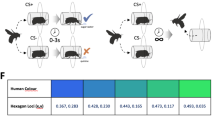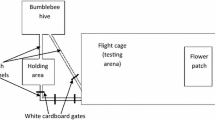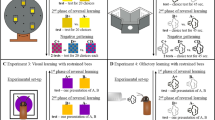Abstract
Bumblebees are capable of rapidly learning discriminations, but flexibility in bumblebee learning is less well understood. We tested bumblebees (Bombus impatiens) on a serial reversal learning task. A serial reversal task requires learning of an initial discrimination between two differentially rewarded stimuli, followed by multiple reversals of the reward contingency between stimuli. A reduction in errors with repeated reversals in a serial reversal task is an indicator of behavioural flexibility. Bees were housed in a large indoor environment and tested during foraging flights. Testing free-flying bees allowed for large numbers of trials and reversals. All bees were trained to perform a simultaneous discrimination between two colours for a nectar reward, followed by nine reversals of this discrimination. Results showed that bumblebees reduced errors and improved their performance across successive reversals. A reduction in perseverative errors was the major cause of the improvement in performance. Bees showed a slight increase in error rate in their final trials, perhaps as a consequence of increasing proactive interference, but proactive interference may also have contributed to the overall improvement in performance across reversals. Bumblebees are thus capable of behavioural flexibility comparable to that of other animals and may use proactive interference as a mechanism of behavioural flexibility in varying environments.






Similar content being viewed by others
References
Avarguès-Weber A, Dyer AG, Giurfa M (2011) Conceptualization of above and below relationships be an insect. Proc R Soc B Biol Sci 278:898–905
Behrend ER, Powers AS, Bitterman ME (1970) Interference and forgetting in bird and fish. Science 167:389–390
Bitterman ME (1965) Phyletic differences in learning. Am Psychol 20:395–410
Bitterman ME (1969) Habit-reversal and probability learning: rats, birds and fish. In: Gilbert RM, Sutherland NS (eds) Animal discrimination learning. Academic Press Inc, New York, pp 163–174
Bitterman ME, Menzel R, Fietz A, Schäfer S (1983) Classical conditioning of proboscis extension in honeybees (Apis mellifera). J Comp Psychol 97:107–119
Bond AB, Kamil A, Balda RP (2007) Serial reversal learning and the evolution of behavioral flexibility in three species of North American corvids (Gymnorhinus cyanocephalus, Nucifraga Columbiana, Aphelocoma californica). J Comp Psychol 121:372–379
Chittka L (1998) Sensorimotor learning in bumblebees: long-term retention and reversal training. J Exp Biol 201:515–524
Chittka L, Niven J (2009) Are bigger brains better? Curr Biol 19:R995–R1008
Couvillon PA, Bitterman ME (1986) Performance of honeybees in reversal and ambiguous-cue problems: tests of a choice model. Anim Learn Behav 14:225–231
Davey G (1989) Ecological learning theory. Routledge, New York
Day LB, Crews D, Wilczynski W (1999) Spatial and reversal learning in congeneric lizards with different foraging strategies. Anim Behav 57:393–407
Devenport LD, Devenport JA (1994) Time-dependent averaging of foraging information in least chipmunks and golden-mantled ground squirrels. Anim Behav 47:787–802
Dornhaus A, Chittka L (2001) Food alert in bumblebees (Bombus terrestris): possible mechanisms and evolutionary implications. Behav Ecol Sociobiol 50:570–576
Duforth RH, Guttman N, Kimble GA (1954) One-trial discrimination reversal in the white rat. J Comp Physiol Psychol 47:248–249
Dukas R (1995) Transfer and interference in bumblebee learning. Anim Behav 49:1481–1490
Dyer AG, Chittka L (2004) Fine colour discrimination requires differential conditioning in bumblebees. Naturwissenschaften 91:224–227
Giurfa M (2003) The amazing mini-brain: lessons from a honey bee. Bee World 84:5–18
Giurfa M (2004) Conditioning procedure and color discrimination in the honeybee Apis mellifera. Naturwissenschaften 91:228–231
Giurfa M, Zhang S, Jenett A, Menzel R, Srinivasan MV (2001) The concepts of ‘sameness’ and ‘difference’ in an insect. Nature 410:930–933
Giurfa M, Schubert M, Reisenman C, Gerber B, Lachnit H (2003) The effect of cumulative experience on the use of elemental and configural visual discrimination strategies in honeybees. Behav Brain Res 145:161–169
Gonzalez RC, Behrend ER, Bitterman ME (1967) Reversal learning and forgetting in bird and fish. Science 158:519–521
Gumbert A (2000) Color choices by bumble bees (Bombus terrestris): innate preferences and generalization after learning. Behav Ecol Sociobiol 48:36–43
Heinrich B (1976) The foraging specializations of individual bumblebees. Ecol Monogr 46:105–128
Heinrich B (1979) Bumblebee economics. Harvard University Press, Cambridge
Heinrich B, Mudge PR, Deringis PG (1977) Laboratory analysis of flower constancy in foraging bumblebees: Bombus ternaries and B. terricola. Behav Ecol Sociobiol 2:247–265
Keasar T, Bilu Y, Motro U, Shmida A (1997) Foraging choices of bumblebees on equally rewarding artificial flowers of different colors. Israel J Plant Sci 45:223–233
Komischke B, Guirfa M, Lachnit H, Malun D (2002) Successive olfactory reversal learning in honeybees. Learn Mem 9:122–129
Mackintosh NJ (1969) Habit-reversal and probability learning: Rats, birds and fish. In: Gilbert RM, Sutherland NS (eds) Animal discrimination learning. Academic Press Inc, New York, pp 175–184
Mackintosh NJ (1974) The psychology of animal learning. Academic Press Inc, New York
Mackintosh NJ, McGonigle B, Holgate V, Vanderver V (1968) Factors underlying improvement in serial reversal learning. Can J Psychol 22:85–95
Menzel R (1969) Das gedächtnis der honigbiene für spektralfarben. II. Umlernene und Mehrfachlernen. Z Vergl Physiol 63:290–309
Menzel R, Giurfa M (2001) Cognitive architecture of a mini-brain: the honeybee. Trends Cogn Sci 5:62–71
Mota T, Giurfa M (2010) Multiple reversal olfactory learning in honeybees. Front Behav Neurosci 4:48
Pahl M, Zhu H, Pix W, Tautz J, Zhang S (2007) Circadian timed episodic-like memory—a bee knows what to do when, and also where. J Exp Biol 210:3559–3567
Pearce JM (2008) Animal learning and cognition, 3rd edn. Psychology Press, Hove
Prabhu C, Cheng K (2008) One day is all it takes: circadian modulation of retrieval of colour memories in honeybees. Behav Ecol Sociobiol 63:11–22
Real LA (1981) Uncertainty and pollinator-plant interactions: the foraging behavior of bees and wasps on artificial flowers. Ecology 62:20–26
Riley JR, Greggers U, Smith AD, Reynolds DR, Menzel R (2005) The flight paths of honeybees recruited by the waggle dance. Nature 435:205–207
Rumbaugh DM (1971) Evidence of qualitative differences in learning processes among primates. J Comp Physiol Psychol 76:250–255
Rumbaugh DM, Savage-Rumbaugh ES, Washburn DA (1996) Toward a new outlook on primate learning and behavior: complex learning and emergent processes in comparative perspective. Jpn Psychol Res 38:113–125
Saleh N, Chittka L (2006) The importance of experience in the interpretation of conspecific chemical signals. Behav Ecol Sociobiol 61:215–220
Shettleworth SJ (1998) Cognition, evolution and behavior. Oxford University Press, New York
Shettleworth SJ (2010) Cognition, evolution and behavior, 2nd edn. Oxford University Press, New York
Stach S, Giurfa M (2005) The influence of training length on generalization of visual feature assemblies in honeybees. Behav Brain Res 161:8–17
Squier LH (1969) Reversal learning improvement in the fish Astronotus ocellatus (Oscar). Psychon Sci 14:143–144
Von Frisch K (1967) The dance language and orientation of bees. Harvard University Press, Cambridge
Von Helversen O (1974) Das experiment: dressurversuche mit bienen. Biol unserer Zeit 4:119–124
Zhang S (2006) Learning of abstract concepts and rules by the honeybee. Int J Comp Psychol 19:318–341
Acknowledgments
We thank Jim Ladich for preparing the bee free-flight facility and Tara Crewe for helpful discussion regarding statistics. This research was supported by a Natural Sciences and Engineering Research Council of Canada Discovery Grant to DFS.
Author information
Authors and Affiliations
Corresponding author
Rights and permissions
About this article
Cite this article
Strang, C.G., Sherry, D.F. Serial reversal learning in bumblebees (Bombus impatiens). Anim Cogn 17, 723–734 (2014). https://doi.org/10.1007/s10071-013-0704-1
Received:
Revised:
Accepted:
Published:
Issue Date:
DOI: https://doi.org/10.1007/s10071-013-0704-1




